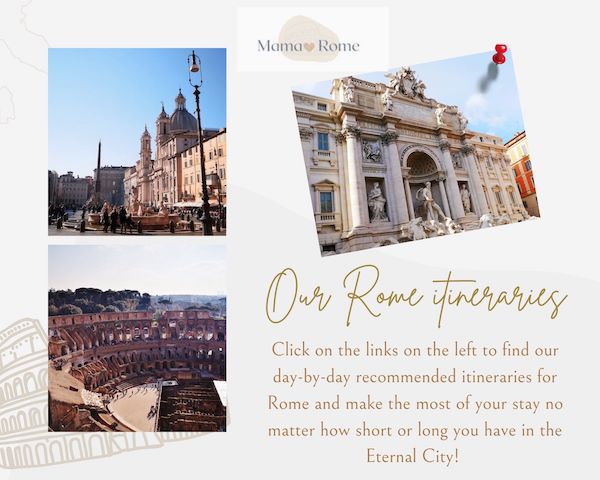Essential visitors’ guide to Piazza di Spagna Rome and is neighborhood: best things to see, where to stay, tips for visiting.
Piazza di Spagna is one of the most famous piazzas in Rome, if not the most famous of all.
Here, you find the iconic Spanish Steps, with the striking backdrop of the church of Trinita’ de’ Monti; here you also find Berninis’ Barcaccia fountain, the start of some of the most elegant and historic streets in Rome and some of the top luxury hotels in the city.
As a tourist, you will find yourself in this area at least once, while visiting Rome city center, possibly much more, depending on your interests and exact plans.
In this essential travel guide to Piazza di Spagna, we share the best things to see in this district and tips for visiting.
Please note: this post contains affiliate links. Should you make a purchase through them, we might make a small commission at no extra cost to you.
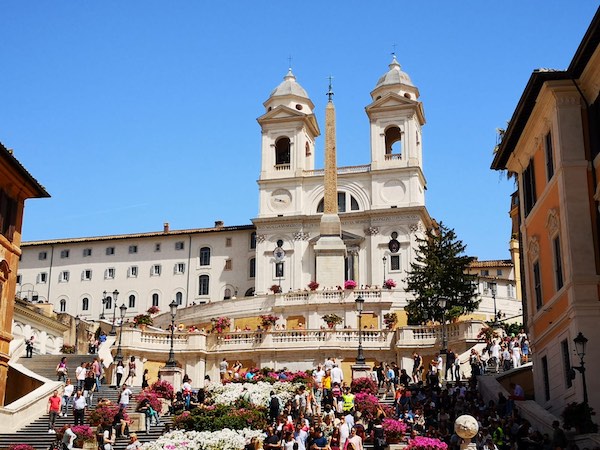
What is special about Piazza di Spagna
The main reason Piazza di Spagna is so famous is the presence of the Spanish Steps (see below).
The steps are one of the most recognizable landmarks in Rome and one of the best known thanks to the many movies that elected them as their backdrop.
Piazza di Spagna is also famous for the presence of an authentic Egyptian ancient obelisk and for a beautiful fountain sculpted by Gian Lorenzo Bernini, one of the most influential artists ever lived in Rome.
Last but not least, Piazza di Spagna is famous for its elegant shops: Valentino, just to name on fashion house, has its atelier just beside the square, in line with the elegant and exclusive feel of the place.
Overall, Piazza di Spagna is special as it is one of Rome’s historical piazzas and one with landmarks from several times in the history of the city, from antiquity to modern days.
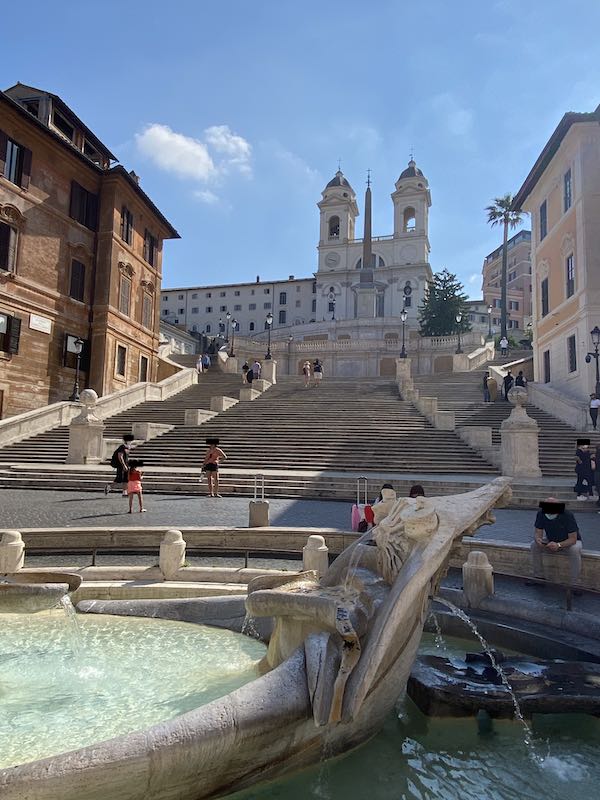
Where is Piazza di Spagna and how to get there
Piazza di Spagna is in Rome city center, close to the Trevi Fountain and at the foothills of the Pincian Hill and the Borghese Gardens.
It is part of Rione IV Campo Marzio, one of Rome’ historical rioni (neighborhoods)
Metro Line A Spagna leaves you on the square: the piazza is mostly pedestrianized so once here, the best way to explore is on foot.
Top tip! Since the piazza and and this area in general has cobbles, make sure you wear comfortable shoes with rubber soles. You can find my tips for choosing the best shoes for Rome here.
Buses do not arrive into the square: this is important to know especially if you are using a bus hop on – hop off tour to discover the city.
The bus can only leave you in the proximity of the square and some walking will be necessary: schedule at least 5-10 mins to get from drop off to the piazza.
A quick history of Piazza di Spagna
Piazza di Spagna as we see it now is a triumph of urban Baroque architecture.
The square lies at the foothills of a tall hill, now entirely covered by the monumental staircase known as the Spanish Steps and leading up to a bi-towered church: Trinita’ dei Monti.
The square and the steps form a continuum.
Piazza di Spagna itself came first.
Because of its position close to Porta del Popolo, the main entrance gate into Rome, Piazza di Spagna always had a strong commercial and travel vocation.
Foreigners would arrive here to rest and water their horses and the area quickly develop hotels and hospitality resource, including embassies, notable the Embassy of France and the Embassy of Spain to the Holy See.
In 1587, Sixtus V consecrated the church of Trinita’ dei Monti and we know that the area, at the time, was rural and covered in vineyards.
In the XVII century, we know Pietro Bernini and is famous son Gian Lorenzo Bernini embellished Piazza di Spagna with their Barcaccia Fountain.
Later, following designs of architect Francesco de Sanctis, the large monumental staircase appeared, as a way to connect the lower part of the square with the top of the hill.
Nowadays, Piazza di Spagna is one of the most famous attractions in Rome and one of the most elegant districts in the city.
What to see in Piazza di Spagna
The Spanish Steps
The most striking feature of Piazza di Spagna is the Spanish Steps.
This monumental staircase came into existence in 1723 – 1726. Its architect Francesco de Sanctis; however, the project for a monumental staircase in this location had been long in the making and had been discusses since the 1500s.
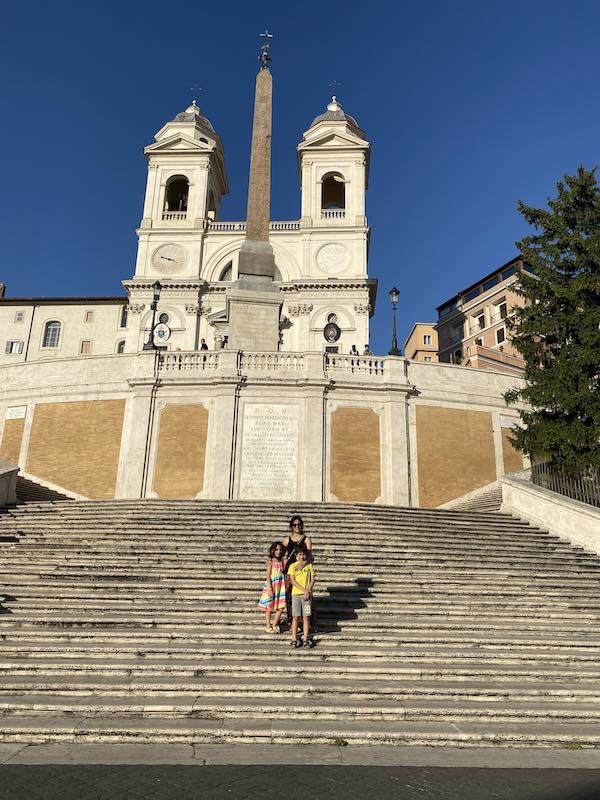
Many projects were submitted and then rejected for various reasons of permits and cost; finally, it all came to fruition in the XVIII century.
It took three Popes for the project to be completed but the inauguration finally took place in 1726.
Several decorative elements on the steps, such as the coat of arms of the House of France and the eagles of the Conti family who overlooked part of hte project, stand as memory of this complex birth.
You can read here >>> all about Rome’s Spanish Steps.
La Barcaccia Fountain
The Barcaccia Fountain is the monumental fountain in the center of Piazza di Spagna, at the bottom of the Spanish Steps.

The fountains dates from and its architects were Bernini father and son, who are said to have worked together at the project.
The fountains was part of a larger urban decor project that involved upgrading of water sources and was financed by the Barberini family, remembered on it by their distinctive family crest with bees.
Barcaccia is unique in Rome: the fountain represents a sunken boat, a peculiar choice of topic that has lead to the birth of local legends about its exact meaning.
Whatever the intention of bernini may have been, this is, without a doubt, one of the the famous fountains in Rome and one of the most unique.
You can read here >>> all about Bernini’s Barcaccia fountain.
Babington’s tea rooms
Babington’s rea rooms are just what the name suggest: and English tea house!
It may feel unexpected, to have an English tea room in a list of things to see while visiting Rome; however, Babingtons’ is a Rome institution and it is part of the texture of the city since its establishment.

Over the course of the centuries and during the Nineteenth century in particular, Rome became a destination of choice of English tourist and travelers, many of which relocated to the city (Keats and Shelley are only the most famous of many).
Babinginton tells us that time; however, it also managed to stay relevant, still offering one one of the best tea experiences in Rome.
Keats and Shelley House
Keats and Shelley House is a museum about English Romantic poets in Rome.
Locates on the side of the Spanish steps, overlooking them, the museum is houses in what used to be Keats’ room in Rome, where he died in 1821.
The museum develops over several rooms and has memorabilia about the the poets, a stunning collection of over 8000 books from writers of the Romantic movement, a cinema room and stunning terraces overlooking the steps.
You can find info and tickets here.
The Sallustian Obelisk
Towards the top of the Spanish Steps, before the last set of steps and on a tall viewing terrace, stands an original Egyptian obelisk known as Obelisco Sallustiano (Sallustian obelisk).
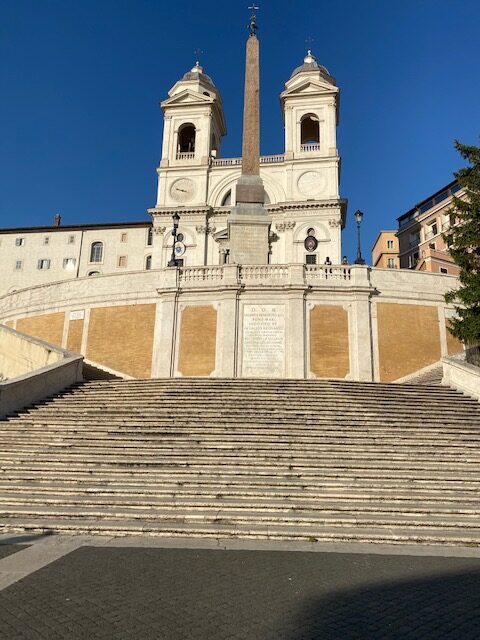
The obelisk is one of the thirteen in Rome and came to the city from Egypt, although no source tells us exactly about the circumstances of its arrival into Rome.
What we know is that the obelisk was originally placed in Emperor Tiberius’ Horti Sallustiani, from where it took its name, and that it came to Rome plain.
The inscriptions and the hieroglyphs we see now are a later additions: Roman carvers added them as decoration but since they were not able to understand Egyptian writing, they did a rather sloppy job.
If you look carefully, you will notice some of the symbols are even upside down!
The obelisk is of red granite and it is 14mt tall. The obese came to Piazza di Spagna in 1787, under Pope Pius VI.
You can read here >>> all about Rome’s obelisks
Church of Trinita’ dei Monti
The church of Trinita’ dei monti (lit. Trinity of the Mounts) is the striking church at the top of the Spanish Steps.
The church is unique in Rome because of its two striking bell towers, otherwise unseen in the city, and seem to have been originally built in the Firtheen centur, by order of teh King of France who owned land in this very location.
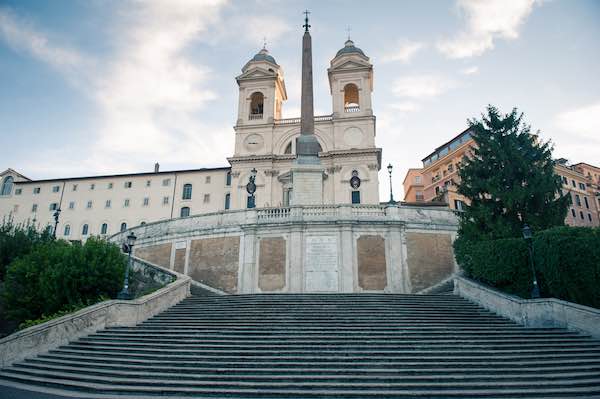
According to sources from that time, King of France Charles VIII initiated the building of a church and convent here for the monastic order of the Minimi, with whom he has a debt of gratitude via their Founder San Francesco di Paola.
At the time, the church has gothic style however, later restoration nd architectural work obliterated those elements and now acquires elements distinctive of later architectural styles.
Worth seeing inside the church are the Altoviti Chapel, the chapel to St Francis of Sales, Lucrezia della Rovere chapel, chapel Bonfire, chapel Elena Orsini and the Borgehse chapels, each decorated with beautiful paintings and sculpture.
The column of the immaculate conception
the column of the immaculate conception is not on Piazza di Spagna proper but on Piazza Mignanelli, effectively a continuation of PIazza di Spagna.
The columns is one of the most distinctive columns in Rome and owes its name to a statue of the Virgin on its top.
The columns was finances by Ferdinand II as a show of loyalty to the church.
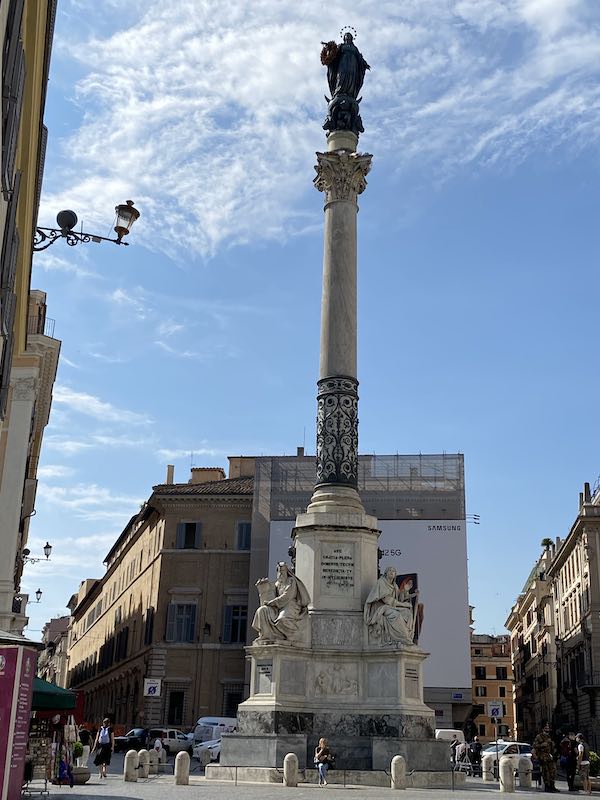
What else to see near Piazza di Spagna
Piazza di Spagna is the very center of Rome and manu attraction are nearby.
The nearest ones are:
- Via Margutta, famous for its art galleries
- Piazza del Popolo, designed by Valadier and with important churches and artworks
- Via del Babuino, Via del Corso, Via di Ripetta, the famous ‘Trident’ of Rome
- Via Condotti, famous for its designer shops and fashion brands
- The Trevi Foutnain
- The Borghese Gardens
Where to stay near Piazza di Spagna
The area of Piazza di Spagna has many hotels, most at the luxury end of the spectrum.
Some you may enjoy are:
Hassler Hotel Roma (luxury), in iconic position on top of the Spanish Steps with enviable views
The Portrait hotel (luxury Aparthotel), with beautiful accommodation with views of the Spanish steps
Hotel Mozart (4-star hotel) close to Piazza di Spagna with beautiful terrace for summer evenings
Hotel Scalinata di Spagna (3-star hotel at the top of the steps)
Internazionale Domus (3-star hotel on Piazza di Spagna)
Crossing Condotti (4-star hotel close to the steps and in the heart of Rome’s most elegant shopping district)
The Inn at the Spanish Steps (4-star hotel with panoramic views of the Spanish Steps from the terrace)
Roccoforte Hotel De Russie (luxury)
Piazza di Spagna 9 (boutique hotel)
Hotel San Carlo (3 star hotel)
Where to eat near Piazza di Spagna
Sofia – good restaurant for lunch or dinner, close to the Piazza di Spagna and Trevi Fountain
La Strega Nocciola – a great place for artisan gelato
Imago restaurant, luxury restaurant of the Hotel Hassler
Babington, the best afternoon tea in Rome and a great address for brunch
Ristorante Crispi 19 upscale restaurant perfect for a special dinner (the fish in particular is exceptional)
Tours of Piazza di Spagna
Piazza di Spagna is included in many tours of Rome.
Some you may enjoy are:
- Best of Rome squares and fountains walking tour
- Piazzas of Rome small group sunset walking tour
- Rome twilight walking and gelato tasting tour
Not sure how to include this attraction in your Rome itinerary? Check our Rome itinerary suggestions below:
Rome in a day: detailed Rome city centre itinerary for first time visitors
Rome in two days A detailed itinerary for two full days in Rome
Rome in three daysRome in four days – day-by-day 3 day Rome itinerary
Rome in five days – complete Rome itinerary with main attractions and less usual sites for visitors with more time in the city
Traveling to Rome with kids? Find our family guide to Rome here.
